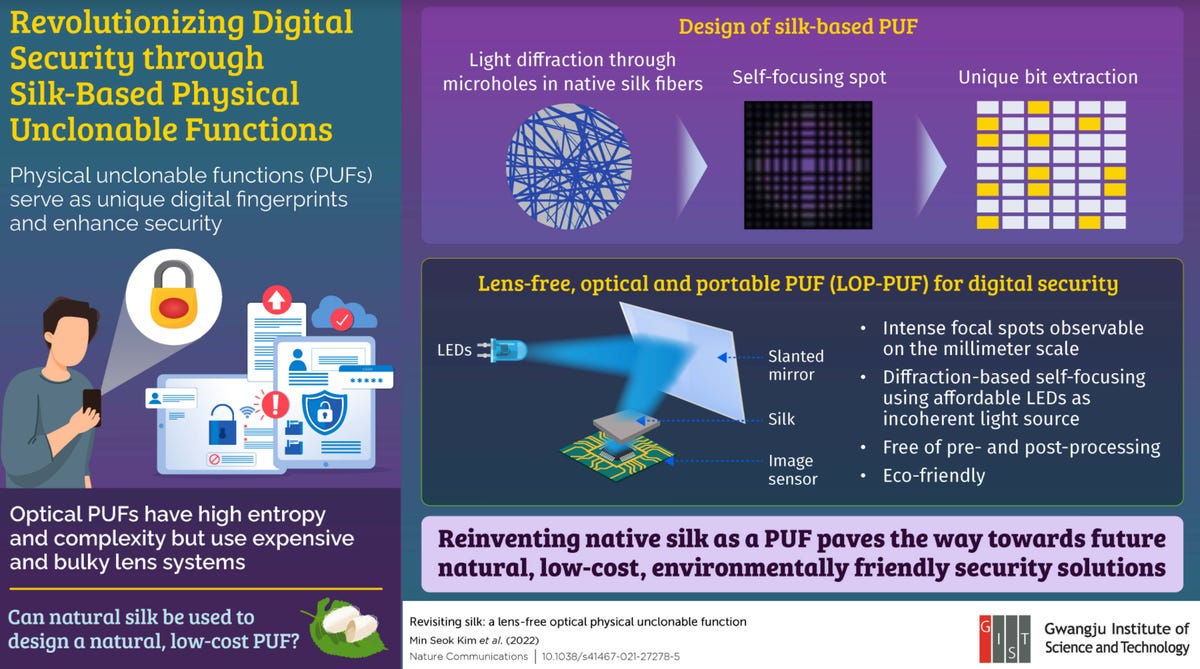Researchers have developed a novel way to potentially improve digital security – the use of silk as a security key.
The proposal is the work of the South Korean Gwangju Institute of Science and Technology (GIST).
In a paper, “Revisiting silk: a lens-free optical physical unclonable function,” published in the academic journal Nature Communications, the researchers argue that the properties of silk could be harnessed to create physical unclonable functions (PUFs).
According to the team, made up of Min Seok Kim, Gil Ju Lee, Jung Woo Leem, Seungho Choi, Young L. Kim, and Young Min Song, PUFs can act as physical security keys for digital services that cannot be duplicated or cloned.
Hardware security keys, including Yubikey products, provide a physical security barrier for online services. Google, for example, recommends that account holders considered more ‘at risk’ of attacks use a hardware-based key in order to reduce the likelihood of compromise by requiring another level of authentication.
According to the GIST researchers, future sustainable and eco-friendly authentication keys could be created by taking advantage of the natural, microscopic differences in fiber – tiny differences that could be used to develop unique, hardware PUFs.
The fibers used to test this idea were obtained from Bombyx mori silkworms. GIST then used an image sensor, light-reflecting mirror, and three light-emitting diodes to capture patterns of light reflected off the silk to create a security tag pattern.
“Randomly distributed fibers in silk generate spatially chaotic diffractions, forming self-focused spots on the millimeter scale,” the paper reads. “The silk-based physical unclonable function has a self-focusing, low-cost, and eco-friendly feature without relying on pre-/post-process for security tag creation.”
Professor Young Min Song explained that at an “optimal density,” a beam of light striking silk causes light diffraction, and this is the source of a potential PUF.
“The nanostructures in individual microfibers enhance the contrast of light intensity with respect to the background,” Song commented. “The diffracted light is then captured by an image sensor. Since the pattern of the microholes is naturally-made, it is unique, giving rise to a unique pattern of light.”
These patterns were then converted into a digital format held in 15 silk “ID cards,” of which an authentication code could then be extracted by a reader. When challenged by a basic brute-force attack, the time calculated for bypassing authentication was reported as 5 x 10(41) years.
“To our knowledge, this is the first PUF module designed using silk, a naturally abundant biomaterial,” Song added. “It means that we don’t need to invest time in developing complicated security keys, nature has already done this for us.”

GIST
Previous and related coverage
Have a tip? Get in touch securely via WhatsApp | Signal at +447713 025 499, or over at Keybase: charlie0
Stay connected with us on social media platform for instant update click here to join our Twitter, & Facebook
We are now on Telegram. Click here to join our channel (@TechiUpdate) and stay updated with the latest Technology headlines.
For all the latest Technology News Click Here
For the latest news and updates, follow us on Google News.
